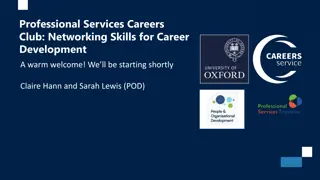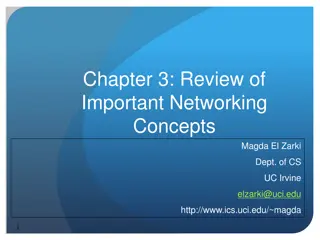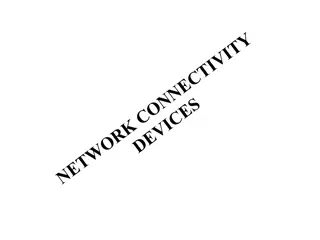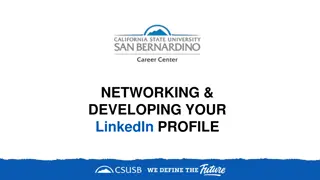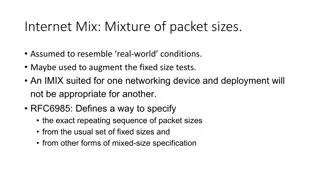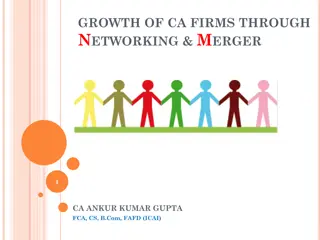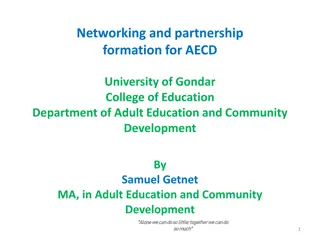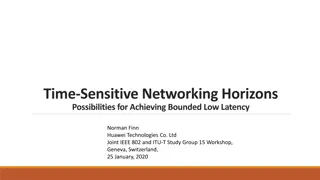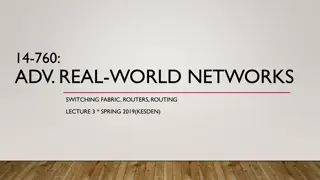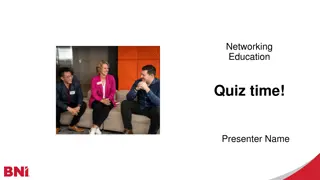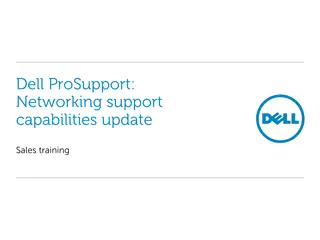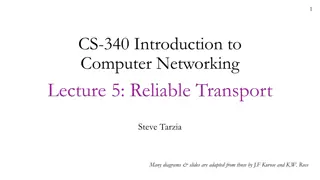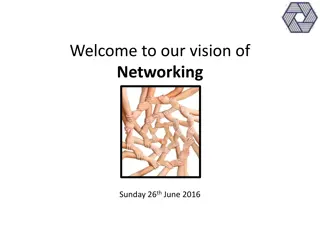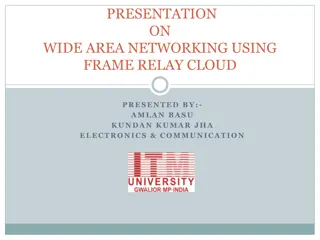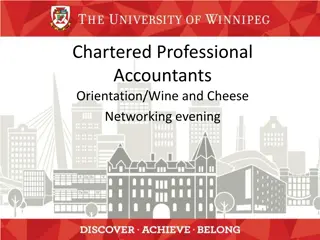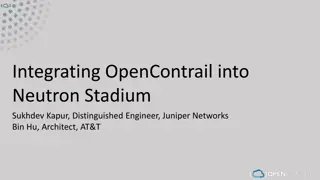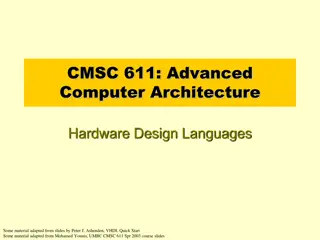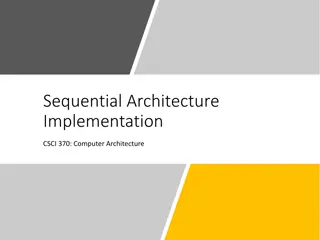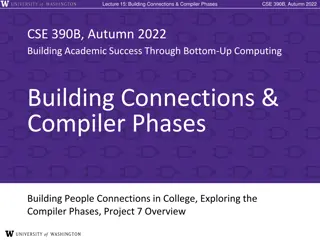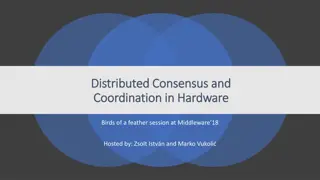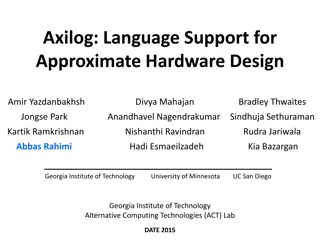Understanding Computer Organization and Architecture
A computer system is a programmable digital electronics device that processes data as per program instructions to provide meaningful output. It comprises hardware and software components, with hardware being the physical parts and software essential for driving the hardware. Computer organization fo
14 views • 71 slides
Mastering Networking for Career Development
Learn about ethical networking, common myths, building networks, and connecting with others. Discover the art of reciprocal relationships to achieve professional goals. Join the Professional Services Careers Club to enhance your networking skills!
4 views • 31 slides
Hold Down and Release Mechanism Hardware Simulator for Ground Deployment Testing
The project involves developing a hardware simulator for testing a Hold Down and Release Mechanism used in Mars Sample Return missions. The simulator aims to replicate the functionality of expensive flight hardware at a lower cost and with reduced lead time. Key requirements include precise activati
3 views • 8 slides
Important Networking Concepts Overview
Review essential networking concepts including protocol architecture, protocol layers, encapsulation, network abstractions, communication architecture, and TCP/IP protocol suite. Understand the functions of different layers in networking for reliable data transfer and communication efficiency.
3 views • 43 slides
Overview of Computer Hardware Components and Software Functions
Computer hardware components such as monitor, CPU, mouse, and projector are essential physical parts of a computer system, while software includes intangible programs like operating systems and utility software. Hardware components perform tasks like displaying data, processing information, and prin
8 views • 9 slides
Understanding Networking Bridges and Transceivers
Bridges in networking play a crucial role in dividing logical bus networks into subnets, improving performance by managing traffic flow. Although network switches have largely replaced bridges today, the advantages of bridges in reducing unnecessary traffic and isolating busy networks remain signifi
0 views • 40 slides
Networking Modes in AWS VPC Environments
Explore different networking modes such as Bridge mode with static mapping, Bridge mode with dynamic mapping, and AWS VPC networking mode in an AWS VPC environment with various configurations and scenarios.
0 views • 18 slides
Unlocking the Power of Networking and Developing Your LinkedIn Profile
Networking is a vital aspect of career growth. Learn the art of networking, both in-person and online. Discover the benefits of LinkedIn and how it can enhance your professional connections. Building a strong network opens up opportunities that may lead to career advancement. Utilize these strategie
0 views • 34 slides
Understanding Cabling Types and Specifications in Networking
Exploring various cabling options like Unshielded Twisted Pair, Shielded Twisted Pair, Coaxial Cable, and Fiber Optic Cable used in networking. Learn about different cable specifications, connectivity types, and cabling orders for efficient networking setups.
0 views • 11 slides
Understanding IMIX in Networking and Testing Tools
IMIX, or Internet Mix, refers to a mixture of packet sizes used to simulate real-world network conditions for testing networking devices. Various tools and methods, such as Genome Reporting, Moongen, T-Rex, and Spirent TestCenter, implement IMIX with specific packet size distributions and characteri
1 views • 8 slides
Growth of CA Firms through Networking & Merger
This document discusses the growth and trends of CA firms in India, focusing on networking, merger, and current practices. It highlights the total number of members, types of firm partnerships, guidelines for networking, current trends in practice, barriers to networking/merger, and the 2021 guideli
0 views • 32 slides
Diploma in Hardware & Networking: Upgrade Your IT Skills
This course provides comprehensive knowledge and practical experience in computer hardware and networking, essential for managing IT infrastructure. Gain expertise in PC hardware maintenance, customer and networking support, and more to pursue a career as a Hardware and Network Engineer. Learn to as
1 views • 8 slides
Networking and Partnership Formation for AECD at University of Gondar College of Education
Networking and partnership formation are vital for Adult Education and Community Development (AECD) at the University of Gondar, emphasizing the power of collaboration and interdependence. Various concepts such as interdependence, independence, and dependence underscore the importance of working tog
0 views • 120 slides
Networking: Mastering the Basics
Learn the principles and importance of networking, debunking myths and exploring real benefits. Discover networking goals, strategies, and conversation starters for effective networking. Enhance career opportunities, build relationships, and develop valuable connections in various settings.
0 views • 13 slides
Anatomy of a Computer System: Hardware Components and Functions
A typical computer system consists of hardware and software working together to perform various computational tasks. The hardware components include the central processing unit (CPU), input/output devices, storage units, and the motherboard. The CPU acts as the main brain of the computer, performing
6 views • 6 slides
Understanding Computer Hardware Components
Computer hardware encompasses the physical components of a computer system that can be touched and felt, such as the motherboard, CPU, RAM, and storage devices like HDD and SSD. Without hardware, essential software cannot run efficiently. This lesson explores the definition, importance, and various
1 views • 6 slides
Exploring Time-Sensitive Networking Horizons and Possibilities for Low Latency Solutions
Delve into the world of time-sensitive networking (TSN) as it offers bounded low-latency solutions for various applications. Discover TSN components, tools, and protocols such as frame replication, path control, per-stream filtering, time synchronization, and more. Gain insights from Jnos Farkas's p
2 views • 23 slides
Networking Fundamentals and Challenges in Data Centers
Today's lecture covers definitions of routing and switching in networking, focusing on data center challenges, traffic patterns, fabric management, and parallelism within networks. The session also explores the role of switches and routers in data center and Internet design, emphasizing the importan
0 views • 38 slides
Understanding the OSI Model and Layered Tasks in Networking
The content highlights the OSI model and layered tasks in networking, explaining the functions of each layer in the OSI model such as Physical Layer, Data Link Layer, Network Layer, Transport Layer, Session Layer, Presentation Layer, and Application Layer. It also discusses the interaction between l
1 views • 41 slides
Networking Education Quiz - Test Your Knowledge!
Test your knowledge on networking education with this quiz featuring questions on SMART goals, INW, BNI basics, leadership team, and more. Challenge yourself to see how much you know about key concepts in the networking field!
0 views • 20 slides
Optimizing DNN Pruning for Hardware Efficiency
Customizing deep neural network (DNN) pruning to maximize hardware parallelism can significantly reduce storage and computation costs. Techniques such as weight pruning, node pruning, and utilizing specific hardware types like GPUs are explored to enhance performance. However, drawbacks like increas
0 views • 27 slides
Overview of Fly and Trajectory Scans in Data Acquisition
Fly and trajectory scans in data acquisition involve software and hardware options for acquiring data while positioners move at constant speeds. Software fly scans enable periodic data acquisition triggered by software, while hardware fly scans rely on pulses from positioners. Hardware fly choices a
0 views • 14 slides
Dell ProSupport Networking Support Capabilities Update Sales Training
This training session provides an overview of Dell ProSupport networking support capabilities, focusing on aligning with industry standards. Participants will learn to discuss networking support needs, understand ProSupport differences, and explore Dell's service portfolio. The session covers expert
0 views • 10 slides
Understanding Reliable Transport and User Datagram Protocol in Computer Networking
This content covers the concepts of reliable transport in computer networking, including the reliable transport layer protocols like TCP, UDP, and the basics of Domain Name Service (DNS). It explains the layers of the Internet, the functions of each layer, and the differences between TCP and UDP pro
0 views • 28 slides
Understanding the Importance of Networking for Community Growth
Networking plays a crucial role in fostering supportive relationships within a community, facilitating the exchange of talents, knowledge, and compassion. This article explores the concept of networking, its benefits, disadvantages, and practical steps to establish a structured network within the Os
0 views • 10 slides
Understanding Wide Area Networking Using Frame Relay Cloud
The field of networking is advancing rapidly, with technologies like cloud computing relying on robust wide area networking. This presentation explores the use of Frame Relay Cloud in improving the security and configuration complexities faced in interconnecting wide area networks. It discusses the
0 views • 16 slides
CPA Orientation Networking Event Tips and Preparation Guide
Discover essential tips and preparation strategies for making the most of a Chartered Professional Accountants (CPA) orientation wine and cheese networking evening. Learn how to engage with recruiters, students, and partners effectively, including what to do, how to prepare, and valuable insights fo
0 views • 5 slides
Integrating OpenContrail into Neutron Stadium - Networking Advancements
Integrating OpenContrail into Neutron Stadium introduces Networking-OpenContrail, bridging OpenContrail with Neutron to enhance network functionality. The project aims to achieve full parity between the two platforms, with active contributors encouraged to join the development efforts. Deployment op
0 views • 7 slides
Understanding Hardware Design Languages in Advanced Computer Architecture
This material covers topics like behavioral correctness, timing simulations, domains, and levels of modeling in hardware design languages. It discusses functional and structural modeling, as well as the use of simulators to analyze and verify system behavior. Hardware Design Languages, behavioral de
0 views • 38 slides
Highlights from ACRP Networking Event in Atlanta
Capturing the essence of the ACRP Networking Event in Atlanta, this collection showcases pictures, comments, and insights shared during the gathering. From insightful discussions on clinical research to networking opportunities and governance transitions within the Atlanta chapter, the event was a h
0 views • 27 slides
Understanding Y86-64 Instruction Set and Hardware Control Language
Delve into the Y86-64 instruction set architecture, exploring sequential architecture implementations for computer architecture. Uncover the various instruction sets and their functionalities, such as halt, nop, call, ret, and more. Additionally, discover the building blocks of hardware, including A
0 views • 51 slides
Building Connections and Compiler Phases in College: Networking Strategies
Discover the benefits of building connections in college through networking strategies like reaching out to professors, TAs, and peers. Learn the importance of networking, ways to get involved on campus, and how to leverage your connections for personal and academic growth.
0 views • 39 slides
Hardware Offload BoF Discussion at Netdev01
Discussion at the Hardware Offload BoF session during Netdev01 focused on preserving the Linux networking model, exchanging ideas on capability determination, and addressing challenges in emulating hardware devices in switch models. Participants explored topics such as managing devices in a generic
0 views • 5 slides
Architectural Hardware Support for Operating Systems in ECE344 Lecture
The lecture discusses the importance of hardware support in operating systems, emphasizing the management of hardware resources and providing a clear interface to programs. It explores the fundamental relationship between operating system functionality and hardware, highlighting how hardware support
0 views • 53 slides
Maximizing Networking Opportunities at Career Fairs and Conferences
Enhance your networking skills with practical tips on approaching strangers, asking insightful questions, and making lasting connections at career fairs and conferences. Understand the importance of networking for knowledge sharing, collaboration, and discovering hidden job opportunities. Learn the
0 views • 21 slides
Distributed Consensus and Coordination in Hardware Birds of a Feather Session
Specialists in distributed consensus and hardware coordination gathered at Middleware 18 for a session hosted by Zsolt István and Marko Vukoli. The session covered topics such as specialized hardware, programmable switches and NICs, P4 language for expressing forwarding rules, and deployment exampl
0 views • 33 slides
Understanding Virtualization: Hardware Abstraction and Hypervisor Concepts
Dive into the world of virtualization with a focus on hardware abstraction and hypervisor technology. Explore the definitions and examples of hardware virtualization, hypervisors, and hardware abstraction, shedding light on how they enable multiple operating systems to coexist on a single physical m
0 views • 21 slides
Understanding Operating Systems: An Introduction and Overview
An operating system is a crucial program that manages computer hardware and serves as an intermediary between users and hardware. This chapter explores the role of operating systems in a computer system, covering components like hardware, application programs, and users. It delves into how operating
0 views • 16 slides
Hardware-Assisted Page Walks for Virtualized Systems
Virtualization in cloud computing and server consolidation relies on hardware-assisted page walks for address translation in virtualized systems. This involves two-level address translations to ensure isolated address spaces for each virtual machine, utilizing multi-level page tables to manage memor
0 views • 32 slides
Approximate Computing in Hardware Design: A Comprehensive Overview
Explore the groundbreaking concepts of approximate computing in hardware design, which involves embracing errors to enhance resource efficiency and performance. Delve into topics such as avoiding worst-case design, criteria for approximate HDL, safety in hardware, and relaxing accuracy requirements
0 views • 31 slides

